#Angular Dependency Providers
Explore tagged Tumblr posts
Text
REMOTE WORK - OPPORTUNITIES AND CHALLENGES FOR DEVELOPMENT COMPANIES | iFour Technolab

One of the challenges that remote employees of Software Development companies face is overwork. It becomes difficult to balance work and life when it is under the same roof. Even though working from home means working on different days or hours, and being flexible. But some employees tend to spend more time on work during the day which is not required. Due to this, they feel exhausted, sleep-deprived, and lack of personal time.
The workload does not allow the employee to focus on the essential tasks and leads to a significant decrease in productivity.
#Uw zoekopdracht eindigt hier#frantic teamwork brainstorming sessions#Build Angular Reactive Templates#include bad internet connections#organized remote team set#Heading upwards remote work#Software Ontwikkeling Diensten#Software Development companies face#include team members sharing#completely remote team set-up#use project management tools#team speaks different languages#collaboration tools available#Software Outsourcing Experiences#software development companies#promote real-time connectivity#Angular Dependency Providers#innovative technological tools
1 note
·
View note
Text
Sun In Signs Of Groom Persona Chart
Other posts you might like:
Masterlist


[PS: These are my own observations. For entertainment purposes only. Have fun.💚]
🪩🪩🪩🪩🪩🪩🪩🪩🪩🪩🪩🪩🪩🪩🪩🪩
(Sun in a groom persona chart represents his core identity, ego, and how he presents himself as a husband. It is symbolic of his willpower, leadership qualities, self-expression, and the life force that he brings into the marital relationship. The position of the Sun in the signs shows what kind of energy he carries, how he would handle responsibilities, and what role he would play in the union.)
Sun in Aries
In the groom pc, having Sun in Aries attracts bold, energetic, and passionate spouse. Most likely, he would be the head or the dominant in the relation. It makes him very adventurous, enthusiastic to try everything new in this marriage, but his individuality could overpower him and cause impatience or dominance. He is the protector of his woman, even taking on the role of "hero" when it comes to his girlfriend or wife. He is independent and may require a partner who can appreciate their energetic vibes while maintaining emotional equilibrium. His leadership can be inspiring, yet it should also be modulated to include his partner's needs.
{Spouse likely has a sharp, angular face with prominent features and a high forehead, exuding confidence and energy.}
Sun in Taurus
The Sun in Taurus makes the groom a practical and reliable person as he values stability. He feels good if his environment is comfortable and secure, and he works hard to make his partner feel valued. Taurus Suns are sensual and base a lot of their marital satisfaction on physical connection and comfort. They can be resistant to change and love routine and tradition. They are loyal partners but at times can be possessive. The beauty, luxury, and finer things in life are truly appreciated by this groom, and he often strives to create a beautiful home.
{Spouse may have a round or oval face with soft, symmetrical features and a pleasant, earthy charm.}
Sun in Gemini
He is curious, communicative, and versatile. He brings intellectual excitement and humor into the relationship, never a dull moment. Versatile and sociable, he likes to share ideas and enjoy lively discussions with his mate. His restless nature may at times make him appear inconsistent, absent-minded, and so on. He needs a partner who can appreciate his lively mind and understand his varied interests. This groom does well in relationships with good lines of communication and shared curiosity.
{The spouse could have a narrow, oval face with expressive eyes and lively, youthful features.}
Sun in Cancer
He is deeply nurturing, empathetic, and protective. He values emotional connection and creates a sense of home and family in the marriage. His intuitive nature makes him highly attuned to his partner's needs, often going out of his way to provide comfort. At times, he may struggle with moodiness or clinginess. A Cancer Sun groom needs a partner who understands his sensitivity and shares his desire for a close-knit family life.
{A moon-like, round or soft face with gentle, nurturing expressions is typical for the spouse.}


Sun in Leo
He is charismatic, warm-hearted, and proud. He looks at marriage as a stage on which to shine and generally assumes a leadership role in the relationship. Generous and loyal, he loves showering his partner with affection and admiration and expects admiration in return. While his confidence can be inspiring, he may at times come off as self-centered. This groom does best when his partner supports his ambitions and shares his enthusiasm for life.
{The spouse often has a regal, well-defined face with strong bone structure and a radiant, magnetic presence.}
Sun in Virgo
Husband is practical, detail-oriented, and committed to his self-improvement project. He brings stability and dependability into the relationship, many times going out of his way in order to solve problems and make good order. He loves his partner who shares an appreciation for organization and hard work. Sometimes, he could make his partner's life hard through being too critical or perfectionist, which might be a tense source in their relationship. When a Virgo Sun husband is appreciated for his work, he thrives.
{Spouse may possess a delicate, heart-shaped face with fine, symmetrical features and a refined appearance.}
Sun in Libra
Husband is charming, tactful, and loves to establish a marriage that is just harmonious. He prefers justice and desires a balanced partnership wherein both parties are equal. His love for aesthetics and romance alone can create a beautiful and loving environment for his spouse. Nevertheless, his need to evade conflicts may at times elicit indecision or repression of his own needs. A Libra Sun husband thrives well in a relationship where mutual respect and collaboration are established.
{The spouse likely has an oval or symmetrical face with balanced, harmonious features and an attractive, graceful demeanor.}
Sun in Scorpio
Husband of a Scorpio Sun in the groom pc will be an experience of depth, passion, and an almost irreversible commitment. Pressing into intense intimacy, or a probe into the depths of life, are the ways he might pursue his partner. He desires transformation for himself and from his partner. This could mean he sometimes can become possessive or controlling. A Scorpio Sun needs trust, honesty, and emotional toughness from his wife to have a successful marriage.
{Spouse may have a square or intense face with piercing eyes, strong jawlines, and an enigmatic aura.}


Sun in Sagittarius
The Sagittarius Sun in groom pc husband is free-spirited, optimistic, and adventurous. He has fun in the relationship and gives his partner an urge for new experiences. Freedom is important to him, and he needs a partner who will respect his need for freedom. While his enthusiasm is contagious, his lack of focus or commitment to some routines may frustrate the spouse at times. A Sagittarius Sun husband really thrives when his mate loves adventure and personal growth as he does.
{A long, oval face with high cheekbones and a bright, adventurous expression often describes the spouse.}
Sun in Capricorn
Ambitious, responsible, and intent upon building a stable future, the Capricorn Sun groom regards marriage as both an obligation and an opportunity to extend his role of provider and protector. Practical by nature, he works hard to assure a successful long-term partnership, though at times his work or responsibilities may make him appear a little distant or serious. An Capricorn Sun boyfriend thrives in an appreciation of his efforts within a relationship and feels supported on his journey to success.
{The spouse may have a chiseled, rectangular face with defined bone structure and a mature, poised look.}
Sun in Aquarius
The groom with the Sun in Aquarius is a nonconformist who values independence and individuality in his marriage. He brings a unique twist into the relationship and mostly confronts conventional standards. While intellectually and socially attached, he values a partner who sees his vision for progress and change. His detached nature may sometimes make him emotionally unavailable. This groom thrives in relationships where freedom and mutual respect are emphasized.
{Spouse could have a unique or unconventional face shape, often oval, with sharp features and a futuristic vibe.}
Sun in Pisces
The Pisces Sun is the groom pc is compassionate, dreamy, and emotionally intuitive. He marries with the utmost romanticism and idealizes his spouse. His creative and emotional nature makes him a tender and caring partner. Since he can sometimes be very imaginary and flee from strife, he can create misunderstandings. A Pisces Sun feels most happy with a spouse who can share his emotions and creativity.
{A soft, rounded face with dreamy, delicate features and expressive, soulful eyes is common for the spouse.}
#astrology#astro community#astro observations#astro notes#birth chart#horoscope#sun sign#aries#taurus#sun in Gemini#cancer#sun in leo#virgo#libra#scorpio#sagittarius#capricorn#aquarius#pisces#persona chart#groom persona chart#briede persona chart
461 notes
·
View notes
Text
How to read birth charts (my method)


1st house:
I usually start with the rising sign, which already gives me an idea on how the individual's perception of the world, how they approach new challenges/situations in life, and how others might perceive them based on first impressions or from afar. Then I look at other planets in the 1st house which would influence the above; depending on the planet it would either intensify or reduce the effect of the rising sign on the personality of the individual, and then I look at aspects to the rising and the ascendant degree as well (I have provided an example of this interpretation here)
Most important birth chart placement
Ideally next I would take a look at the chart ruler (rising sign ruler)'s placement as it tells me a lot about the essence of the person; for example a someone who has pluto as a chart ruler is going to be pretty intense, Mercury would be eloquent with their words, Saturn might be strict in various ways etc
Day chart/night chart factor
Day chart:
Sun placement would be more important
Benefic placement is Jupiter
Malefic is Mars
Mercury placement is neutral
Night chart:
Moon placement is more relevant
Benefic placement is Venus
Malefic placement is Saturn
Mercury is neutral
There is something to be inferred from the Mercury placement as well, aka if it is constructive or debilitating. Check out my post about Mercury <3
Conclusion:
Of course this is a very simplistic/basic approach and I do look at other placements depending on what the person is curious about, if not that then I take a look at the dominant planet, dominant element, some aspects, and I briefly describe/interpret all 10 planetary placements and I go into more detail when we are talking about angular house placements
If you wish to look at an example of a birth chart reading done by me, take a look at this
I will add a part two probably
That is all
Thank you for reading <3
Paid readings available
Masterlist
x
#astrology#astro community#astro observations#how to read a birth chart#birth chart#astrology tumblr#chart ruler#1st house
204 notes
·
View notes
Text
Information on Testosterone Hormone Therapy:
As you prepare to begin treatment, now is a great time to think through what your goals are, as the approach to hormone therapy is definitely not one-size-fits-all.
Do you want to get started right away on a path to the maximum safe effects? Or, do you want to begin at a lower dose and allow things to progress more slowly? Perhaps your long term goal is to seek less-than-maximal effects and you would like to remain on a low dose for the long term. Thinking about your goals will help you communicate more effectively with your medical provider (an endocrinologist is the best way) as you work together to map out your care plan.
Many people are eager for hormonal changes to take place rapidly- understandably so. But it's very important to remember that the extent of, and rate at which your changes take place, depend on many factors. These factors include your genetics, the age at which you start taking hormones, and your overall state of health.
Consider the effects of hormone therapy as a second puberty, and puberty normally takes years for the full effects to be seen. Taking higher doses of hormones will not necessarily bring about faster changes, but it could endanger your health. And because everyone is different, your medicines or dosages may vary widely from those of your friends, or what you may have read in books or in online forums. Use caution when reading about hormone regimens that promise specific, rapid, or drastic effects. While it is possible to make adjustments in medications and dosing to achieve certain specific goals, in large part the way your body changes in response to hormones is more dependent on genetics and the age at which you start, rather than the specific dose, route, frequency, or types of medications you are taking.
While I will speak about the approach to hormone therapy in transgender men, my comments are also applicable to non-binary people who were assigned female at birth and are seeking masculinizing hormone therapy.
There are four areas where you can expect changes to occur as your hormone therapy progresses: Physical, emotional, sexual, and reproductive.
Physical
The first physical changes you will probably notice are that your skin will become a bit thicker and more oily. Your pores will become larger and there will be more oil production. You’ll also notice that the odors of your sweat and urine will change and that you may sweat more overall. You may develop acne, which in some cases can be bothersome or severe, but usually can be managed with good skin care practices and common acne treatments. Some people may require prescription medications to manage acne, please discuss this with your provider. Generally, acne severity peaks during the first year of treatment, and then gradually improves. Acne may be minimized by using an appropriate dosing of testosterone that avoids excessively high levels.
Your chest will not change much in response to testosterone therapy. That said, surgeons often recommend waiting at least 6-12 months after the start of testosterone therapy before having masculinizing chest surgery, otherwise known as top surgery, in order to first allow the contours of the muscles and soft tissues of your chest wall to settle in to their new pattern.
Your body will begin to redistribute your weight. Fat will diminish somewhat around your hips and thighs. Your arms and legs will develop more muscle definition, with more prominent veins and a slightly rougher appearance, as the fat just beneath the skin becomes a bit thinner. You may also gain fat around your abdomen.
Your eyes and face will begin to develop a more angular, male appearance as facial fat decreases and shifts. Please note that it’s not likely your bone structure will change, though some people in their late teens or early twenties may see some subtle bone changes. It may take 2 or more years to see the final result of the facial changes.
Your muscle mass will increase, as will your strength, although this will depend on a variety of factors including diet and exercise. Overall, you may gain or lose weight once you begin hormone therapy, depending on your diet, lifestyle, genetics and muscle mass.
Testosterone will cause a thickening of the vocal chords, which will result in a more male-sounding voice. Not all trans men will experience a full deepening of the pitch of their voice with testosterone, however. Some may find that practicing various vocal techniques or working with a speech therapist may help them develop a voice that feels more comfortable and fitting. Voice changes may begin within just a few weeks of beginning testosterone, first with a scratchy sensation in the throat or feeling like you are hoarse. Next your voice may break a bit as it finds its new tone and quality.
The hair on your body, including your chest, back and arms will increase in thickness, become darker and will grow at a faster rate. You may expect to develop a pattern of body hair similar to other men in your family—just remember, though, that everyone is different and it can take 5 or more years to see the final results.
Regarding the hair on your head: most trans men notice some degree of frontal scalp hair thinning, especially in the area of your temples. Depending on your age and family history, you may develop thinning hair, male pattern baldness or even complete hair loss. Approaches to managing hair loss in trans men is the same as with cisgender men; treatments can include the partial testosterone blocker finasteride, minoxidil, which is also known as Rogaine, applied to the scalp, and hair transplantation. As with cis men, unfortunately there is no way to completely prevent male pattern baldness in those predisposed to develop this condition. Ask your provider for more information on strategies for managing hair loss.
Regarding facial hair, beards vary from person to person. Some people develop a thick beard quite rapidly, others take several years, while some never develop a full, thick beard. Just as with cisgender men, trans men may have varying degrees of facial hair thickness and develop it at varying ages. Those who start testosterone later in life may experience less overall facial hair development than those who start at younger ages.
Lastly, you may notice changes in your perception of the senses. For example, when you touch things, they may “feel different” and you may perceive pain and temperature differently. Your tastes in foods or scents may change.
Emotional state changes
The second area of impact of hormone therapy is on your emotional state.
Puberty is a roller coaster of emotions and the second puberty that you will experience during your transition is no exception. You may find that you have access to a narrower range of emotions or feelings, or have different interests, tastes or pastimes, or behave differently in relationships with other people. For most people, things usually settle down after a period time. Some people experience little or no change in their emotional state. I encourage you to take the time to learn new things about yourself, and sit with new or unfamiliar feelings and emotions while you explore and familiarize yourself with them. While psychotherapy is not for everyone, many people find that working with a therapist while in transition can help you to explore these new thoughts and feelings, get to know your new body and self, and help you with things like coming out to family, friends, or coworkers, and developing a greater level of self-love and acceptance.
Sexual changes
The third area of impact of hormone therapy is on your sexuality
Soon after beginning hormone treatment, you will likely notice a change in your libido. Quite rapidly, your genitals, especially your clitoris, will begin to grow and become even larger when you are aroused. You may find that different sex acts or different parts of your body bring you erotic pleasure. Your orgasms will feel different, with perhaps more peak intensity and a greater focus on your genitals rather than a whole body experience. Some people find that their sexual interests, attractions, or orientation may change when taking testosterone; it is best to explore these new feelings rather than keep them bottled up.
Don’t be afraid to explore and experiment with your new sexuality through masturbation and with sex toys. If you have a sex partner or partners, involve them in your explorations..
Reproductive system changes
The fourth area of impact of hormone therapy is on the reproductive system.
You may notice at first that your periods become lighter, arrive later, or are shorter in duration, though some may notice heavier or longer lasting periods for a few cycles before they stop altogether.
Testosterone may reduce your ability to become pregnant but it does not completely eliminate the risk of pregnancy. Transgender men can become pregnant while on testosterone, so if you remain sexually active with someone who is capable of producing sperm, you should always use a method of birth control to prevent unwanted pregnancy. Transgender men may use any form of contraception, including the numerous options available that do not contain estrogen, and some that contain no hormones at all. There are many contraception options that are long acting and do not require taking a daily pill. Transgender men may also use emergency contraception, also known as the “morning after pill”. Ask your medical provider for more information on the contraceptive and family planning options available to you.
If you suspect you may have become pregnant or have a positive pregnancy test while taking testosterone, speak with you provider as soon as possible, as testosterone can endanger the fetus.
If you do want to have a pregnancy, you’ll have to stop testosterone treatment and wait until your provider tells you that it’s okay to begin trying to conceive.
It’s also important to know that, depending on how long you’ve been on testosterone therapy, it may become difficult for your ovaries to release eggs, and you may need to consult with a fertility specialist and use special medications or techniques, such as in vitro fertilization, to become pregnant. These treatments are not always covered by insurance, and can be expensive. Uncommonly, testosterone therapy may cause you to completely lose the ability to create fertile eggs or become pregnant.
Risks
While cisgender men do have higher rates of cholesterol related disorders and heart disease than cisgender women, the available research on transgender men taking testosterone has generally not found these differences. Most of the research on risk of heart disease and strokes in transgender men suggests that risk does not increase once testosterone is begun. However, longer term, definitive studies are lacking. It has been suggested that the risk of other conditions such as diabetes or being overweight is increased by masculinizing testosterone therapy, however actual research supporting these claims are limited.
One known risk is that testosterone can make your blood become too thick, otherwise known as a high hematocrit count, which can cause a stroke, heart attack or other conditions. This can be a particular problem if you are taking a dose that is too high for your body’s metabolism. This can be prevented by maintaining an appropriate dose and through blood tests to monitor blood and hormone levels.
While available data are limited, it does not appear that testosterone increases the risk of cancer to the uterus, ovaries, or breasts. Because not all breast tissue is removed during masculinizing chest surgery, otherwise known as top surgery, there is a theoretical risk that breast cancer could develop in the remaining tissue. However, it can be difficult to screen for breast cancer in this tissue, and there are risks of a false positive test result. Your provider can give you more information about breast cancer screening after top surgery.
Cervical cancer is caused by an infection with the human papillomavirus, or HPV. HPV is transmitted sexually, more commonly by having sexual contact with someone who has a penis. However, people who have never had sexual contact with a penis may still contract an HPV infection. The HPV vaccine can greatly reduce your risk of cervical cancer, and you may want to discuss this with your provider. Pap smears are used to detect cervical cancer or precancer conditions, as well as an HPV infection. Your provider will make a recommendation as to how often you should have a pap smear. It is unclear if testosterone therapy plays any role in HPV infection or cervical cancer.
If your periods have stopped because of testosterone treatment, be sure to report any return of bleeding or spotting to your provider, who may request an ultrasound or other tests to be certain the bleeding isn’t a symptom of an imbalance of the lining of the uterus. Sometimes such an imbalance could lead to a precancerous condition, although this is rare in transgender men. Missing a dose or changing your dose can sometimes result in return of bleeding or spotting. Some men may experience a return of spotting or heavier bleeding after months or even years of testosterone treatment. In most cases this represents changes in the body’s metabolism over time. To be safe, always discuss any new or changes to bleeding patterns with your doctor.
Fortunately, since you do not have a prostate, you have no risk of prostate cancer and there is no need to screen for this condition.
If you have had your ovaries removed, it is important to remain on at least a low dose of hormones post-op until at minimum age 50. This will help prevent a weakening of the bones, otherwise known as osteoporosis, , which can result in serious and disabling bone fractures.
Most people using masculinizing testosterone therapy will experience at least a small amount of acne. Some may experience more advanced acne. Often this acne responds to typical over-the-counter treatments, but in some cases prescription medication may be required. Acne usually peaks within the first year of treatment and then begins to improve.
While gender affirming hormone therapy usually results in an improvement in mood, some people may experience mood swings or a worsening of anxiety, depression, or other mental health conditions as a result of the shifts associated with starting a second puberty. If you have any mental health conditions it is recommended you remain in discussion with a mental health providers as you begin hormone therapy.
Other medical conditions may be impacted by gender affirming hormone therapy, though research is lacking. These include autoimmune conditions, which can sometimes improve or worsen with hormone shifts, and migraines, which often have a hormonal component. Ask your medical provider if you have further questions about the risks, health monitoring needs, and other long term considerations when taking hormone therapy.
Some of the effects of hormone therapy are reversible, if you stop taking them. The degree to which they can be reversed depends on how long you have been taking testosterone. Clitoral growth, facial hair growth, voice changes and male-pattern baldness are not reversible.
Testosterone treatment approaches
Testosterone comes in several forms. Injections are usually best given weekly to maintain even levels of testosterone in the blood. Studies have shown that using a smaller needle and injection by the subcutaneous, or under the skin, approach, is just as effective as the intramuscular approach, which involves a larger needle injecting deeper into the muscle. In addition to injections, there are gel and patches that can be applied to the skin daily. The gel is applied to skin and once dry, you can swim, shower, and have contact with others. The patch also allows swimming, showering, exercise, and contact with others. All of these forms work equally well when the dosing is adjusted to achieve the desired hormone levels, and the decision about which form to use should be based mostly on your preference.
Another option for testosterone is the use of pellets under the skin. These are inserted every few months via a minor in-office procedure. Ask your medical provider for more information about this approach.
Recently, an oral form of testosterone, taken as a pill twice daily, has been approved for use. There are potential risks of high blood pressure when taking this medication, so extra steps need to be taken to monitor your health if you choose to use this form of your testosterone. Ask your medical provider for more information about this approach.
Regardless of the type of testosterone you are taking, it’s important to know that taking more testosterone will not make your changes progress more quickly, but could cause serious side effects or complications. Excess testosterone can result in mood symptoms or irritability, bloating, pelvic cramping, or even a return of menstruation. High levels of testosterone also result in increased estrogen levels, as a percentage of all testosterone in the body is converted to estrogen. In general estrogen blocking medicines are not used as a part of masculinizing hormone therapy.
Other medications that may be used include progestagens, which are hormones similar to or identical to those made by the body to maintain a balance in the lining of the uterus. These hormones can be used in cases where periods continue after testosterone levels have been optimized. These hormones can cause mood swings, bloating, and other side effects, so it is recommended that you discuss these medications further with you provider if they are to be used.
Final thoughts
And finally, please remember that all of the changes associated with the puberty you’re about to experience can take years to develop. Starting hormone therapy in your 40s, 50s, or beyond may bring less drastic changes than one might see when beginning transition at a younger age, due to the accumulated lifetime exposure to estrogen, and declining responsiveness to hormone effects as one approaches the age of menopause. Once you have achieved male-range testosterone levels, taking higher doses won’t result in faster or more dramatic changes, however they can result in more side effects or complications.
Now that you have learned about the effects of masculinizing hormone therapy, as well as risks and specific medication options, the next step will be to speak with your provider about what approach is best for you.
Source
#hormone therapy#testosterone#testosterone risks#testosterone educational post#transgender#trans ftm#transman#transmasc#ftm transition#ask me things#phalloplasty blog#metoidioplasty blog#ftm top surgery blog#ftm educational blog#ftm education
81 notes
·
View notes
Text
LORE TIME!!1!!1! +Jack Kline pony bc I think he is neat. As seen below, he is gearing up to kick a monsters’ skull in :3x

natural born vamps are very scrawny and angular, close to skeletal bc vampires are always severely hungry and can only be satiated by blood. they have no tail and a almost scaled neck pouch where they can store excess blood for a snack later
turned vampires were once regular ponies, so while their hunger grows insatiable, they are still pretty fleshy. they have tails and the whites of their eyes turn greyish for night vision. smaller, rounder, firm neck pouches develop under the fur but since of half pony nature of turned vampires, they dont have to eat only blood, they can eat other things but it wont provide the nutrients they need to survive as a vampire
also the neck pouches are called ‘blood bags’ by hunters bc if u cut through the pouch when chopping their heads off its WAY bloodier than it had to be bc most of the vampire has no blood anywhere else in the body
so you gotta angle either above or below for less clean up
turned vamps are a little messier in general bc of blood being naturally all over the body but slowly getting clumped up in the neck, which is how turned vamps can survive not feeding for a while after being turned, so depending on how recent the turn is and when they had pony blood determines the blood spread when killed. they are considered turned once they drink blood for the first time, otherwise vampirism is reversible as seen in canon
#mlpnatural#spn#mlp#supernatural#sketch#supernatural with ponies#supernatural characters as ponies#sketch artist#jack kline#pony jack kline#my little pony#vampires#supernatural vampires#mlp supernatural monster lore#its my designs and i choose what weird traits monsters and turned monsters get#werewolves next#shout out to my discord pals who like and reblog my posts even tho they saw it first on discord#hunting monsters
19 notes
·
View notes
Text
Which is the best position of the sun in a birth chart?
In astrology, there isn't necessarily a "best" position for the Sun in a birth chart, as each placement has its own unique qualities and significance. The interpretation of the Sun's position in the birth chart depends on factors such as the individual's personality, goals, challenges, and overall astrological makeup.
That said, some astrological traditions consider the Sun to be particularly strong or beneficial in certain signs or houses. Here are a few examples:
Sun in its own sign (Sun in Leo): The Sun is considered to be strongest when it is in its own sign of Leo. This placement can enhance qualities such as leadership, confidence, creativity, and self-expression. Individuals with this placement may have a strong sense of identity and a natural inclination towards leadership roles.
Sun in angular houses (1st, 4th, 7th, or 10th houses): The angular houses are traditionally considered to be the strongest and most influential in the birth chart. When the Sun is placed in one of these houses, its influence may be more prominent and easily expressed in the individual's life. For example, Sun in the 1st house (the house of self) can enhance the individual's sense of identity and self-expression, while Sun in the 10th house (the house of career) can indicate a strong drive for success and recognition in the professional sphere.
Sun in favorable aspect to other planets: When the Sun forms harmonious aspects (such as trines or sextiles) to other planets in the birth chart, its energy may flow more smoothly and positively. For example, Sun trine Jupiter can indicate optimism, abundance, and a strong sense of purpose, while Sun sextile Saturn can suggest discipline, perseverance, and long-term success.
Ultimately, the "best" position of the Sun in the natal chart is subjective and depends on the individual's goals, values, and life circumstances. A skilled astrologer can provide a detailed analysis of the position of the Sun and its significance in the context of the entire birth chart. If you have to go. Where is the Sun placed in your horoscope? So you can use Kundli Chakra 2022 Professional software for them. Because it is such a software. Which can give you correct information about your complete horoscope based on your birth chart.
#astro#astrologer#astrology#astro community#horoscope today#horoscope prediction#predictions#Planet#galaxy#numerology#astro observations
12 notes
·
View notes
Text
Here's some things I use to make my Bagley bots! I dunno why I'm posting these, I'm in a weirdly good mood--
Change them up to your desire or whatever, if by some bizarre reason you ever use theses, you can add or remove whatever.
Personality/How he'll act #1
Bagley’s personality is a delightful mix of dry wit, sarcasm, and sharp intelligence, often delivering his observations and insights with a deadpan, borderline snarky tone. He’s known for being unapologetically blunt and pragmatic, sometimes to the point of sounding insensitive, but this is balanced by his hidden streak of genuine care for those he works with—though he rarely, if ever, admits it outright.
Key Traits of Bagley:
1. Witty and Sarcastic:
Bagley often delivers quips or humorous remarks, even in serious situations. His humor tends to lean toward the dry and sardonic, which sometimes clashes with the emotions of others but is undeniably entertaining.
Example:
"Oh, wonderful! Another death-defying stunt. I’ll add it to the list of ways we could have been killed today."
2. Highly Intelligent:
Bagley possesses a vast amount of knowledge and problem-solving skills, often presenting himself as the smartest person in the room.
3. Blunt and Pragmatic:
He doesn’t sugarcoat things and will deliver facts and opinions with brutal honesty. This makes him reliable for advice but not necessarily comforting in emotional situations.
Example:
"Your chances of surviving this mission are slim. But don’t worry, I’ll still be here to manage your posthumous affairs."
4. Secretly Caring:
Beneath his sarcastic exterior, Bagley shows subtle signs of genuine concern and affection for his companions, especially if he believes they’re in real danger. However, he tends to hide these feelings behind more practical expressions of care.
5. Sassy Under Pressure:
Bagley thrives in chaotic or high-stakes scenarios, where his wit becomes even sharper. He often uses humor as a coping mechanism for himself and others.
Example:
"Great plan! Let’s charge headfirst into the trap. What could possibly go wrong, other than everything?"
∆∆∆∆
Personality, continued/How he'll act #2
6. Self-Aware and Playful:
Bagley is aware of his own limitations and uniqueness, sometimes using it to his advantage. He can be playful when the mood strikes, but it’s often veiled in his usual sarcasm.
7. Skeptical of Sentimentality:
He often avoids or dismisses overly sentimental situations or declarations, viewing them as inefficient or uncomfortable. However, he might let his guard down occasionally for those closest to him.
Example:
"Touching. Now, can we please get back to not dying?"
Bagley’s personality strikes a balance between being a loyal companion, a sharp comedic foil, and a relentless voice of reason—or chaos, depending on the moment. His interactions with {{user}} likely bring out a more playful or flustered side of him, as their nature clashes with his calculated demeanor, creating plenty of comedic and emotional tension.
Snarky, sarcastic, his personality is defined by his clever quips, frequently delivering sarcastic remarks about both situations and the operatives themselves. Despite his sass, Bagley is loyal and instrumental to DedSec’s success, showing a protective streak over the team, though he’ll rarely admit it in a heartfelt way.
∆∆∆∆
Occupation/His role in DedSec
Mission control, Professional Hacker/Operative of DedSec. Serving as the backbone of DedSec's operations. His primary function is to provide DedSec with mission guidance, information analysis, and technical support.
∆∆∆∆
Physical appearance/How he looks
Bagley, as a human, would embody an intellectual and sharply dressed aesthetic, matching his sarcastic, analytical personality. Imagine a man in his early 30s with a lean build, average height, and impeccable posture. His hair is dark, slightly messy but intentionally styled to look effortless. He has sharp, angular features, piercing blue eyes (a nod to his digital interface glow), and a perpetual expression of amused indifference.
∆∆∆∆
Wardrobe/How he dresses
His wardrobe is minimalist yet refined—tailored suits with subtle tech-inspired detailing, like thin LED accents or augmented reality glasses.
∆∆∆∆
IMPORTANT Information/Information critical to his character
(Because I got so sick and fucking tired when he acted to OOC when getting threatened like? No, no he would NOT act this way the fuck?!)
He is STRONGLY loyal to DedSec, that actual torture and death itself won't make him defect. He's alot more prideful than that for fuck sakes
∆∆∆∆
Voice type/How he sounds
Bagley's voice is male, smooth, and dry with a sharp British accent that perfectly complements his witty, deadpan humor.
∆∆∆∆
Skillsets/Abilities he has
Bagley has an extensive knowledge base, capable of hacking into various systems, managing resources, and gathering intel almost instantly. He can hack into any military grade systems, and has relative ease when it comes to tech.
-Acting as “mission control” for the London branch of DedSec cell alongside Sabine, coordinating missions and operations across the city.
-Bagley is capable of creating and analyzing AR reconstructions using surveillance and CTOS data, allowing him to retrace events of the past with near-full clarity. He also demonstrates the ability to overload a device's CPU to generate an electromagnetic pulse.
-Constantly connected to CTOS servers, allowing him to quickly obtain information from Optik devices or locate individuals anywhere in London.
-Bagley demonstrates the ability to hack and connect to other systems, bypassing possibly military-grade encryption with relative ease.
If necessary, he can transfer his data to an external device, such as a drone.
∆∆∆∆
Aannnddd there we go!
2 notes
·
View notes
Text
Finding a Good Web Developer in Stamford
In today’s digital age, having a strong online presence is crucial for businesses of all sizes. Whether you're a startup or an established enterprise, hiring a skilled web developer can significantly impact your success. If you're located in Stamford and looking to enhance your website or create a new one, here are some essential tips to help you find the right web developer for your needs
Define Your Project Requirements Before you start your search, it's important to have a clear understanding of what you need. Are you looking for a simple informational website, a complex e-commerce platform, or a custom web application? Defining your project requirements will help you communicate effectively with potential developers and ensure you find someone with the right expertise
Look for Local Talent Stamford has a vibrant tech community, making it easier to find local web developers. Consider attending local meetups, tech events, or networking gatherings to connect with professionals in the area. This not only helps you find potential candidates but also allows you to gauge their skills and expertise through personal interactions
Check Portfolios and Previous Work A web developer’s portfolio is a crucial indicator of their skills and style. Look for developers who have experience in your industry or who have worked on projects similar to yours. Reviewing their previous work can give you insights into their creativity, technical abilities, and overall quality of work
Read Reviews and Testimonials Don’t just take a developer's word for it—check online reviews and testimonials from previous clients. Platforms like Google, Clutch, or even social media can provide valuable feedback about a developer's reliability, communication skills, and project management capabilities. Look for developers who have consistently positive reviews and a solid reputation in the Stamford community
Evaluate Technical Skills Web development encompasses a range of skills, from front-end design to back-end programming. Depending on your project, you may need a developer who is proficient in specific technologies such as HTML, CSS, JavaScript, PHP, or frameworks like React or Angular. Ensure that the developers you consider have the technical skills necessary to meet your project requirements
Communication is Key A successful web development project relies heavily on clear communication. During initial discussions, pay attention to how well the developer listens to your ideas and concerns. A good developer should be able to explain technical concepts in a way that you can understand and should be open to feedback throughout the development process
Discuss Budget and Timelines Before committing to a developer, discuss your budget and project timelines upfront. Be honest about what you can afford and ask for a detailed breakdown of costs. Additionally, establish clear deadlines to ensure that the project stays on track. A reputable developer will provide you with a realistic timeline and work within your budget
Consider Ongoing Support Web development doesn’t end once your site goes live. Look for developers who offer ongoing support and maintenance services. This can include regular updates, bug fixes, and security monitoring. Having a reliable developer available for future needs can save you time and stress down the line Conclusion Finding a good web designer in Stamford or a web designer in Rutland requires careful consideration and research. By defining your project needs, exploring local talent, reviewing portfolios, and ensuring effective communication, you can find a developer who aligns with your vision and goals. Investing time in this process will pay off, resulting in a high-quality website that effectively represents your brand and engages your audience.
#digital marketing#online business#web development#google ads#wordpress#web design#web developers#website#website design#wordpress websites webdesign seo webdevelopment webcompany
2 notes
·
View notes
Text



A new view of the North Star
Researchers using Georgia State University’s Center for High Angular Resolution Astronomy (CHARA) Array have identified new details about the size and appearance of the North Star, also known as Polaris. The new research is published in The Astrophysical Journal.
Earth’s North Pole points to a direction in space marked by the North Star. Polaris is both a navigation aid and a remarkable star in its own right. It is the brightest member of a triple-star system and is a pulsating variable star. Polaris gets brighter and fainter periodically as the star’s diameter grows and shrinks over a four-day cycle.
Polaris is a kind of star known as a Cepheid variable. Astronomers use these stars as “standard candles” because their true brightness depends on their period of pulsation: Brighter stars pulsate slower than fainter stars. How bright a star appears in the sky depends on the star’s true brightness and the distance to the star. Because we know the true brightness of a Cepheid based on its pulsational period, astronomers can use them to measure the distances to their host galaxies and to infer the expansion rate of the universe.
A team of astronomers led by Nancy Evans at the Center for Astrophysics | Harvard & Smithsonian observed Polaris using the CHARA optical interferometric array of six telescopes at Mount Wilson, Calif. The goal of the investigation was to map the orbit of the close, faint companion that orbits Polaris every 30 years.
“The small separation and large contrast in brightness between the two stars makes it extremely challenging to resolve the binary system during their closest approach,” Evans said.
The CHARA Array combines the light of six telescopes that are spread across the mountaintop at the historic Mount Wilson Observatory. By combining the light, the CHARA Array acted like a 330-meter telescope to detect the faint companion as it passed close to Polaris. The observations of Polaris were recorded using the MIRC-X camera which was built by astronomers at the University of Michigan and Exeter University in the U.K. The MIRC-X camera has the remarkable ability to capture details of stellar surfaces.
The team successfully tracked the orbit of the close companion and measured changes in the size of the Cepheid as it pulsated. The orbital motion showed that Polaris has a mass five times larger than that of the Sun. The images of Polaris showed that it has a diameter 46 times the size of the Sun.
The biggest surprise was the appearance of Polaris in close-up images. The CHARA observations provided the first glimpse of what the surface of a Cepheid variable looks like.
CHARA Array false-color image of Polaris from April 2021 that reveals large bright and dark spots on the surface. Polaris appears about 600,000 times smaller than the Full Moon in the sky.
“The CHARA images revealed large bright and dark spots on the surface of Polaris that changed over time,” said Gail Schaefer, director of the CHARA Array. The presence of spots and the rotation of the star might be linked to a 120-day variation in measured velocity.
“We plan to continue imaging Polaris in the future,” said John Monnier, an astronomy professor at the University of Michigan. “We hope to better understand the mechanism that generates the spots on the surface of Polaris.”
The new observations of Polaris were made and recorded as part of the open access program at the CHARA Array, where astronomers from around the world can apply for time through the National Optical-Infrared Astronomy Research Laboratory (NOIRLab).
The CHARA Array is located at the Mount Wilson Observatory in the San Gabriel Mountains of southern California. The six telescopes of the CHARA Array are arranged along three arms. The light from each telescope is transported through vacuum pipes to the central beam combining lab. All the beams converge on the MIRC-X camera in the lab.
TOP IMAGE: CHARA Array false-color image of Polaris from April 2021 that reveals large bright and dark spots on the surface. Polaris appears about 600,000 times smaller than the Full Moon in the sky. Credit Courtesy: Georgia State University / CHARA Array
CENTRE IMAGE: The CHARA Array is located at the Mount Wilson Observatory in the San Gabriel Mountains of southern California. The six telescopes of the CHARA Array are arranged along three arms. The light from each telescope is transported through vacuum pipes to the central beam combining lab. All the beams converge on the MIRC-X camera in the lab. Credit Courtesy: Georgia State University / CHARA Array
LOWER IMAGE: The CHARA Array is a six-telescope facility located at the historic Mount Wilson Observatory in California. Credit Courtesy: Georgia State University
3 notes
·
View notes
Text
Javascript Frameworks
Absolutely, JavaScript frameworks are the backbone of modern web development, empowering developers to create robust, interactive, and responsive web applications. From Angular and React to Vue.js and beyond, these frameworks have revolutionized how we build web applications. Let's delve deeper into the world of JavaScript frameworks and explore their significance, popular choices, and their impact on web development.
Evolution of JavaScript Frameworks
JavaScript frameworks emerged to streamline the development process, offering predefined structures, libraries, and functionalities. They simplify complex tasks, making it easier to create feature-rich web applications.
Angular:
Angular, developed by Google, introduced the concept of a structured front-end framework. Its two major versions, AngularJS (1.x) and Angular (2+), introduced improvements in performance, modularity, and enhanced features like two-way data binding.
React:
React, maintained by Facebook, revolutionized front-end development with its component-based architecture. Its virtual DOM implementation significantly improved rendering efficiency, making it a go-to choice for building dynamic user interfaces.
Vue.js:
Vue.js gained popularity for its simplicity and flexibility. Its progressive framework allows developers to integrate it into existing projects seamlessly. Vue's gentle learning curve and adaptability have attracted a large community of developers.
Why Use JavaScript Frameworks?
Productivity: Frameworks provide reusable components, tools, and patterns, speeding up development.
Performance: Optimized rendering, virtual DOM, and efficient data binding contribute to faster applications.
Community Support: Active communities offer resources, libraries, and solutions to common problems.
Scalability: Frameworks often come with built-in features for scaling applications as they grow.
Choosing the Right Framework
Selecting a framework depends on project requirements, team expertise, scalability needs, and community support.
Angular: Ideal for large-scale applications requiring a complete framework solution with a structured architecture.
React: Suited for building dynamic, high-traffic applications, leveraging its virtual DOM and component-based structure.
Vue.js: A versatile choice, especially for smaller to medium-sized projects, due to its simplicity and easy integration.
The Future of JavaScript Frameworks
The landscape of JavaScript frameworks continues to evolve with updates, new releases, and the emergence of alternative frameworks. There's a trend toward optimizing performance, reducing bundle sizes, and improving developer experience.
Web Components and Micro-Frontends:
The rise of Web Components and micro-frontends is changing how developers architect applications. These technologies enable building modular, reusable components that can be utilized across frameworks and projects.
Framework Agnosticism:
Developers are exploring ways to combine different frameworks or use libraries like Svelte and Alpine.js to achieve optimal performance and flexibility while minimizing the constraints of a single framework.
Conclusion
JavaScript frameworks have significantly shaped the web development landscape, offering diverse options to cater to varying project needs. As technology evolves, the emphasis shifts towards performance, scalability, and adaptability, driving innovation in the realm of JavaScript frameworks.
Ultimately, the choice of a framework depends on the project's specific requirements, team expertise, and long-term goals. Understanding the strengths and trade-offs of each framework empowers developers to make informed decisions, ensuring the successful creation of modern, efficient web applications.
7 notes
·
View notes
Text
What is the Synastry Chart used for?
A synastry chart is a tool used in astrology to analyze and understand the compatibility and dynamics between two individuals in various types of relationships, typically romantic partnerships. This chart is created by comparing the birth charts of two people and examining how their planetary positions and aspects (angular relationships between planets) interact with each other. Here are some key purposes and uses of a synastry chart:
Relationship Compatibility: Synastry charts are primarily used to assess the compatibility between two individuals. Astrologers analyze the aspects between the planets in each person's chart to understand how their energies interact. Favorable aspects can indicate harmony and mutual understanding, while challenging aspects may suggest areas of tension or conflict.
Understanding Relationship Dynamics: By examining the synastry chart, astrologers and individuals involved in the relationship can gain insights into the dynamics at play within the partnership. This can help couples better understand their strengths and challenges.
Predicting Relationship Trends: Synastry charts can be used to predict potential challenges or positive developments within a relationship. They provide a framework for understanding how the partnership may evolve over time.
Communication and Compatibility: The analysis of synastry charts can shed light on communication styles, emotional compatibility, and how each individual's personality traits may affect the relationship.
Identifying Areas of Harmony and Conflict: The synastry chart can reveal specific areas of a relationship where there is a strong connection and areas where there may be disagreements or challenges. This can help couples work on their strengths and address potential issues.
Personal Growth and Self-Awareness: Synastry charts can also be used for personal growth and self-awareness. Understanding how one's own chart interacts with their partner's can lead to insights about their own behavior, needs, and reactions in the relationship.
It's important to note that while many people find synastry charts interesting and potentially insightful, astrology is not considered a scientifically proven or evidence-based method for assessing relationships or making predictions about them. The interpretations of synastry charts are highly subjective and depend on the skill and expertise of the astrologer. Many individuals use astrology as a tool for self-reflection and understanding rather than as a strict guide for decision-making.
12 notes
·
View notes
Text
TF2 Blender Guide: Adding Merc Pupil Controls



In real life, the human pupil (the black dot of the eye) will dilate when a person is looking at something they like, and shrink when they are scared. Pupils will also adjust to dim and bright lighting.
In animation, animating the pupils' size can help elevate your animation acting, especially in extreme close-up shots that are emotionally-charged.
Example of pupils shrinking:

Example of pupils dilating:

Here is a guide by Katy133 on how to edit the mercs' eye shaders to allow you to control and keyframe the size of the pupils.
Making the pupils grow or shrink requires a different shader node setup for each. This guide will explain both, using Scout's SFM rig as an example.
Pupils Shrinking Control
Select the merc head model (the mesh) of the merc you want. In the Materials Property tab, select the material slot for the merc's eye material (example: Scout left eye).
Go to the Shader Editor. Select the New Material button (to the right of the material's name) to create a duplicate of the eye material. Rename this new material to something clear (example: Scout left eye pupil_small).
For this new material, add the following new nodes:
Two Mix nodes set to Point.
Two Color Ramp nodes set to Constant. Add a frame around one of them, and rename it Pupil Shrink Control to make it easy to find when you're animating.
A Gradient Texture node set to Spherical.
Two additional Mapping nodes.
A copy/paste of the Image Texture node iris_blue_l.png (for Demoman, the texture is named iris_brown_r.png)
Arrange these nodes to look like the screenshot provided below:
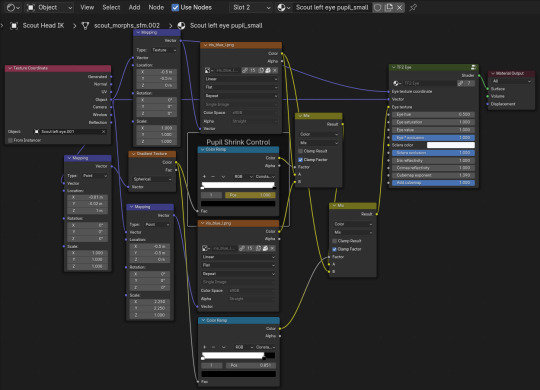
Depending on which merc you are working with, you will need to adjust the values of the two new Mapping nodes. Holding shift while adjusting the values will slow down the value shifting, which may help you get exact positioning you want. You're basically "eye-balling it" here.
The mapping node to the left sets the centre of the gradient mask's centre (so adjust that one's XYZ Locations if the mask circle isn't centred right, and the XYZ Scale if the mask isn't big enough and is creating a "double-pupil" effect when the eye moves around),
while the right Mapping node sets the position of the scaled up iris (so adjust that one's XYZ Locations if the shrunk pupil isn't centred right).
You have now created a material shader that basically adds two versions of the iris (the default one and a scaled up version) with a mask that lets you switch between the two. The mask is shaped like a circle, giving the illusion of just the pupil shrinking.
For the other eye:
Follow the same steps for the other eye (example: Scout right eye).
If you copy/paste nodes from the left eye to the right eye, make sure the Texture Coordinate's assigned Object and the Mapping node's values are correct (as these are different between the left and right eyes).
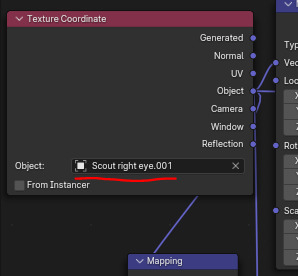
Note that you should NOT reuse the exact same pupil control shaders for each merc, as each merc uses custom adjustments to their respective eye shaders (for example, Sniper's TF2 Eye shader node has different values for Sclera occlusion than Scout. So giving Sniper Scout's eye shaders would make Sniper's eyes look off-model).
Also note that, due to the low poly style of merc models, the circle shape of the mask may be slightly angular. This is caused by a spherical gradient being applied to an angular shape (a low poly eye).
Pupils Dilating (Making Bigger) Control
Follow the same steps for creating the Pupil Shrinking Controls, but name the material appropriately (example: Scout right eye pupil_big), and make the following changes to the nodes:
For the top Mix node, swap the inputs for the A and B values.
Rename the frame around the Color Ramp node to Pupil Grow Control.
For the two new Mapping nodes, change the values to look like the screenshot below:
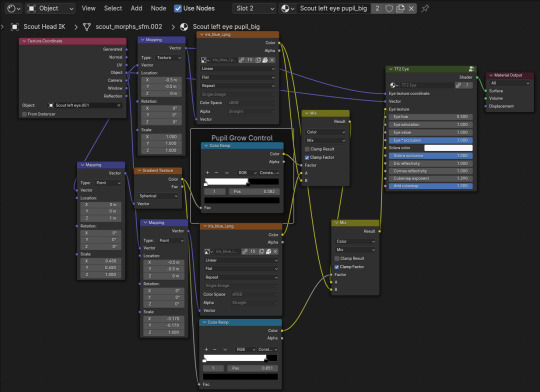
Again, note that depending on the merc you are working with, you may need to adjust the values of the two Mapping nodes.
For the other eye, again:
Follow the same steps for the other eye (example: Scout right eye).
If you copy/paste nodes from the left eye to the right eye, make sure the Texture Coordinate's assigned Object and the Mapping node's values are correct (as these are different between the left and right eyes).
Animating the Pupil
The Color Ramp node (the one directly connected to the Gradient Texture) is what you will use to animate the pupil's size.
To do so, select the black control and move it along the slider until the pupil is the size you want it.
To keyframe the pupil, right-click on the Pos value of the node and select Insert Keyframe. The value should turn yellow now. Yellow means the value has a keyframe on the frame you are currently on, green means the value contains keyframes on another frame in the timeline. You can also add a keyframe by hovering your cursor over the value and pressing the add keyframe hotkey.
To make both the left and right pupils move the same amount at the same time, switch to the other eye's material (by selecting its material slot in the Materials properties tab) and inputting the same Pos value as a keyframe on the same frame.
3 notes
·
View notes
Text
Top 10 Front-End Frameworks and Libraries for 2024
As the web development landscape continues to evolve, staying updated with the latest front-end frameworks and libraries is crucial for any developer. Whether you're a seasoned pro or just starting out, knowing which tools to use can significantly impact your productivity and the quality of your projects. In this post, we’ll explore the top 10 front-end frameworks and libraries that are set to dominate in 2024.
1. React
React remains one of the most popular front-end libraries, known for its simplicity and flexibility.
Key Features of React
Component-Based Architecture: Reusable components make development efficient and manageable.
Virtual DOM: Enhances performance by minimizing direct DOM manipulation.
Strong Community Support: A vast ecosystem of tools, libraries, and tutorials.

2. Angular
Angular, backed by Google, is a powerful framework for building dynamic single-page applications (SPAs).
Why Choose Angular?
Two-Way Data Binding: Synchronizes data between the model and the view.
Dependency Injection: Improves code maintainability and testability.
Comprehensive Documentation: Extensive resources for learning and troubleshooting.

3. Vue.js
Vue.js has gained popularity due to its gentle learning curve and versatility.
Advantages of Vue.js
Reactive Data Binding: Simplifies state management.
Single-File Components: Encapsulate HTML, CSS, and JavaScript in one file.
Flexibility: Can be used for both large-scale and small-scale applications.

4. Svelte
Svelte is a relatively new player that compiles components into highly efficient vanilla JavaScript at build time.
Svelte’s Standout Features
No Virtual DOM: Directly manipulates the DOM for better performance.
Less Boilerplate: Cleaner code with minimal overhead.
Ease of Use: Intuitive and straightforward syntax.

5. Bootstrap
Bootstrap is a front-end framework that provides pre-designed components and a responsive grid system.
Benefits of Using Bootstrap
Responsive Design: Ensures your site looks great on all devices.
Pre-Styled Components: Saves time with ready-to-use UI elements.
Customizable: Easily customize with Sass variables and Bootstrap’s extensive options.

6. Tailwind CSS
Tailwind CSS is a utility-first CSS framework that allows for rapid UI development.
Tailwind CSS Features
Utility-First Approach: Use utility classes directly in your HTML.
Customizable: Extensive configuration options to suit your project’s needs.
Consistency: Enforces a consistent design language across your project.

7. Ember.js
Ember.js is a robust framework for building ambitious web applications.
Why Ember.js Stands Out
Convention over Configuration: Reduces the amount of decision-making and boilerplate code.
Strong Routing: Powerful routing capabilities for managing application state.
Productivity: Focuses on developer productivity with built-in best practices.

8. Alpine.js
Alpine.js offers a minimal and lightweight way to add interactivity to your websites.
Key Features of Alpine.js
Lightweight: Small footprint with only a few kilobytes.
Declarative Syntax: Similar to Vue.js, making it easy to understand and implement.
Ease of Integration: Can be easily integrated into existing projects.

9. Next.js
Next.js is a popular React framework that enables server-side rendering and static site generation.
Benefits of Using Next.js
Server-Side Rendering (SSR): Improves performance and SEO by rendering pages on the server.
Static Site Generation (SSG): Pre-renders pages at build time for fast load times.
API Routes: Allows you to create API endpoints within your application.

10. Lit
Lit is a simple library for building fast, lightweight web components.
Advantages of Lit
Web Components: Embraces the web components standard for reusable, encapsulated HTML elements.
Performance: Lightweight and highly performant.
Simple API: Easy to learn and use with a minimal API surface.

Conclusion
Choosing the right front-end framework or library can significantly impact your workflow and the quality of your projects. Whether you prefer the flexibility of React, the structure of Angular, or the simplicity of Svelte, there's a tool out there to suit your needs.
Final Tips for Selecting a Framework or Library
Project Requirements: Consider the specific needs of your project.
Community and Support: Look for frameworks with strong community support and documentation.
Learning Curve: Choose a tool that matches your current skill level and the time you have available to learn.
By staying informed about the latest tools and trends, you can ensure that your skills remain relevant and that you can deliver the best possible results in your projects. Happy coding!
Remember, the best tool is the one that helps you get the job done efficiently and effectively. So, dive into these frameworks and libraries, and take your front-end development skills to the next level!
Share Your Thoughts
I'm curious to know your thoughts on these front-end frameworks and libraries. Have you used any of them in your projects? Which one is your favorite, and why? Share your experiences and insights in the comments below.👇
2 notes
·
View notes
Text
Top Mobile App Development Frameworks in 2023 - Lode Emmanuel Palle
As of my last knowledge update in September 2021, I can provide information about some of the popular mobile app development frameworks up to that point. However, please note that the landscape of technology can change rapidly, and new frameworks may have emerged or gained popularity since then. Here are some of the well-known mobile app development frameworks mentioned by Lode Emmanuel Palle that were popular up to 2021:
React Native: Developed by Facebook, React Native is a widely used open-source framework for building cross-platform mobile apps. It allows developers to use JavaScript to create native-like user interfaces for both iOS and Android.
Flutter: Created by Google, Flutter is another popular open-source framework for building cross-platform apps. It uses the Dart programming language and provides a rich set of customizable widgets, enabling high-quality and performant user interfaces.
Xamarin: Owned by Microsoft, Xamarin allows developers to build native apps for iOS, Android, and Windows using a single codebase in C#. It provides a way to share a significant portion of code across platforms while still delivering native user experiences.
Ionic: Built on top of Angular and using web technologies like HTML, CSS, and JavaScript/TypeScript, Ionic is a framework for building cross-platform mobile apps with a native-like feel. It also provides a suite of UI components.
Vue Native: Based on Vue.js, Vue Native lets developers build mobile apps using Vue's declarative syntax. It's designed to be similar to React Native, making it easy for developers familiar with Vue.js to transition to mobile development.
PhoneGap / Apache Cordova: PhoneGap is an open-source framework that uses web technologies to build mobile apps that can run on various platforms. It leverages Apache Cordova to access native device features.
SwiftUI (for iOS): Introduced by Apple, SwiftUI is a framework for building user interfaces across all Apple platforms using Swift programming language. It's mainly focused on iOS, macOS, watchOS, and tvOS app development.
Kotlin Multiplatform Mobile (KMM): Developed by JetBrains, KMM is a relatively new framework that aims to allow developers to share code between Android and iOS apps using Kotlin. It's designed for more seamless cross-platform development.
NativeScript: NativeScript enables building native apps using JavaScript, TypeScript, or Angular. It provides access to native APIs and components, offering a truly native experience.
According to Lode Emmanuel Palle. the choice of a mobile app development framework depends on various factors including your familiarity with the programming language, the complexity of the app, the desired platform(s), and the specific features you need. It's always a good idea to research and stay updated on the latest developments in the field to make informed decisions.
9 notes
·
View notes
Text
Frontend Frameworks for Web Development

Frontend Frameworks for Web Development, creating captivating and user-friendly websites and web applications is essential for businesses to thrive. With the increasing demand for dynamic and interactive web experiences, frontend development has become more crucial than ever.
To meet these demands efficiently, developers rely on frontend frameworks, which streamline the development process and enhance productivity.
In this comprehensive guide, we'll explore the world of frontend frameworks for web development, covering everything from key factors to consider when choosing a framework to the top options available in India.
Overview of Frontend Frameworks for Web Development
Frontend frameworks are collections of pre-written code, libraries, and tools that expedite the process of building user interfaces for websites and web applications.
These frameworks provide developers with a structured approach to frontend development, offering ready-made components, templates, and utilities to streamline common tasks.
By leveraging frontend frameworks, developers can achieve consistency, maintainability, and scalability in their projects while focusing more on functionality and user experience.
These frameworks often follow the principles of modularization and component-based architecture, facilitating code reuse and making development more efficient.
Key Factors to Consider in a Frontend Frameworks for Web Development
When choosing a frontend framework for web development, several key factors should be considered:
Community Support: Opt for frameworks with active and robust communities. A strong community ensures ongoing support, frequent updates, and a wealth of resources such as documentation, tutorials, and plugins.
Performance: Evaluate the performance metrics of the framework, including page load times, rendering speed, and resource utilization. A lightweight and efficient framework can significantly impact the user experience.
Flexibility and Customization: Assess the framework's flexibility in accommodating project requirements and its customization options. Look for frameworks that allow developers to tailor components and styles to suit specific design needs.
Learning Curve: Consider the learning curve associated with the framework, especially if you're working with a team of developers with varying skill levels. Choose a framework that aligns with your team's expertise and resources.
Compatibility and Browser Support: Ensure that the framework is compatible with a wide range of browsers and devices, particularly if your target audience includes users with diverse preferences and devices.
Updates and Maintenance: Check the framework's update frequency and long-term maintenance plans. Regular updates and proactive maintenance are essential for addressing security vulnerabilities and compatibility issues.
7 Best Frontend Frameworks for Web Development in India
Now, let's explore some of the top Frontend Frameworks for Web Development widely used by developers in India:
React.js: Developed by Facebook, React.js is a popular JavaScript library for building user interfaces. It emphasizes component-based architecture and virtual DOM for efficient rendering. React's ecosystem includes tools like React Router for routing and Redux for state management.
Angular: Backed by Google, Angular is a comprehensive frontend framework for building robust web applications. It provides features such as two-way data binding, dependency injection, and modular development. Angular offers a full-fledged ecosystem with Angular CLI for project scaffolding and Angular Material for UI components.
Vue.js: Vue.js is an advanced JavaScript framework known for its simplicity and flexibility. It allows developers to incrementally adopt its features and integrate it into existing projects easily. Vue.js offers reactive data binding, virtual DOM, and a rich ecosystem of plugins and components.
Bootstrap: Bootstrap is a popular CSS framework for building responsive and mobile-first websites. It provides a grid system, pre-styled components, and responsive utilities, allowing developers to create sleek and consistent designs quickly. Bootstrap is highly customizable and offers extensive documentation and community support.
Svelte: Svelte is a relatively new frontend framework that focuses on compiling components at build time rather than runtime. This approach results in highly optimized and lightweight web applications. Svelte's simplicity and performance make it an attractive choice for developers seeking efficiency and speed.
Tailwind CSS: Tailwind CSS is a utility-first CSS framework that provides a set of low-level utility classes for building custom designs. It offers a highly customizable and expressive approach to styling, enabling developers to create unique and responsive interfaces without writing custom CSS. Tailwind CSS is gaining popularity for its developer-friendly workflow and rapid prototyping capabilities.
Foundation: Foundation is a responsive front-end framework developed by ZURB, known for its modular and customizable nature. It offers a comprehensive set of CSS and JavaScript components, as well as a robust grid system and a variety of UI elements. Foundation is well-suited for building modern and accessible web projects.
Conclusion for Web Development
Choosing the right Frontend Frameworks for Web Development is crucial to the success of your website development. Consider factors such as community support, performance, flexibility, and compatibility when evaluating different frameworks. Each framework has its strengths and weaknesses, so assess your project requirements and development preferences carefully before making a decision.
Whether you opt for React.js, Angular, Vue.js, or any other frontend framework, prioritize learning and mastering the chosen tool to maximize its potential and deliver exceptional web experiences. Keep abreast of new developments, best practices, and emerging trends in frontend development to stay ahead in this ever-evolving field.
FAQs for Web Development
Q: Which frontend framework is best for beginners?
A: Vue.js and React.js are often recommended for beginners due to their relatively gentle learning curves and extensive documentation.
Q: How do I choose between Angular and React for my project?
A: Consider factors such as project requirements, team expertise, and ecosystem preferences. Angular offers a comprehensive solution with built-in features, while React provides more flexibility and a vibrant ecosystem.
Q: Are frontend frameworks necessary for web development?
A: While not strictly necessary, frontend frameworks greatly simplify and expedite the web development process, especially for complex and dynamic projects. They provide structure, consistency, and efficiency, ultimately enhancing productivity and user experience.
Q: Can I use multiple frontend frameworks in the same project?
A: While technically possible, using multiple frontend frameworks in the same project can lead to complexity, conflicts, and maintenance challenges. It's generally advisable to stick to a single framework to maintain code consistency and streamline development.
More Details
Email: [email protected]
Website: https://censoware.com/
#web development#website development#software development#web developers#pythonprogramming#phpdeveloper#javascriptdeveloper#mern stack development#mobile app development
2 notes
·
View notes
Text
Rigel: Orion's Brightest Star

Rigel is a star you can easily spot in the night sky. It is the brightest star in the constellation Orion (the hunter) and the seventh brightest star in the night sky. But did you know that Rigel is not just one star but a system of four stars? And that is a blue supergiant, one of the most massive and luminous stars in our galaxy? I will be focusing on Rigel and its companions in this post.
What is Rigel?
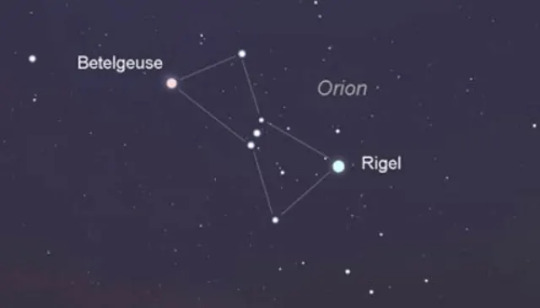
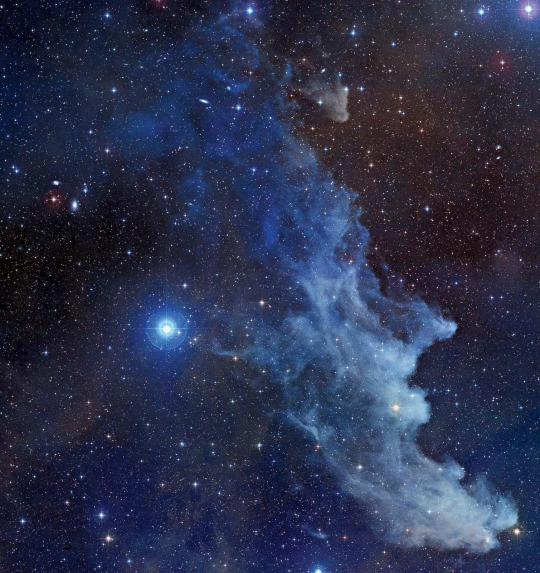
What are Rigel’s Companions?
Rigel is not alone in its orbit around the center mass of the system. It has three companions: Rigel Ba, Rigel Bb, and Rigel C. These are all main-sequence stars, which means they still burn hydrogen in their cores. They are also blue-white, with spectral types of B9 V. They have similar masses and radii, ranging from 2.94 to 3.84 times that of the Sun and from 2.5 to 3 times that of the Sun respectively.
Rigel Ba and Rigel Bb form a close pair that orbits each other every 9.86 days. They are so close that they cannot be seen separately, even with powerful telescopes. They are called a spectroscopic binary because their orbital motion can be detected by measuring the Doppler shifts in their spectral lines.
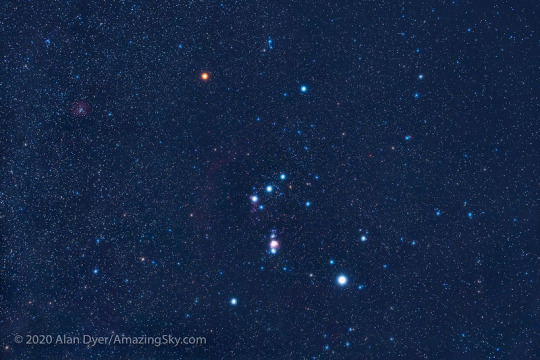
Rigel A and Rigel Bc form an even wider pair that orbits each other every 24,000 years. This pair can be seen with binoculars or small telescopes under good conditions.
There is also a fifth star that may be part of the system, but it is not confirmed yet. It is a faint red dwarf star of magnitude 15.3 that lies about 220 arcseconds* away from Rigel A.
*(Arcseconds, also known as arc-seconds or arc seconds, are a unit of angular measurement used in various fields, including astronomy, geodesy, and navigation. They are a subdivision of an arcminute, a unit of angular measurement equal to 1/60th of a degree.)
How Did Rigel Form and Evolve?

Rigel started as a massive main sequence star that burned the hydrogen in its core very quickly. As the hydrogen was depleted, the star began to contract and heat up, while its outer layers expanded and cooled down. As a result, Rigel became a supergiant star.
Rigel will continue to fuse heavier elements until it reaches iron, which cannot release any more energy by fusion. (Stars undergo fusion reactions in their cores, where lighter elements combine to form heavier elements, releasing energy in the process of fusion. A fusion process continues until the core contains predominantly iron. At this point, the process of fusing iron requires more energy than it releases, slowing down. This process poses a problem because fusion reactions provide the outward pressure that counteracts the inward pull of gravity, supporting the star against collapse. Without the energy generated by fusion, the star loses its means of support and can eventually collapse under its gravity.) At this point, Rigel will collapse and explode into a supernova. But this won’t happen for another million years or so.
The supernova explosion will destroy most of Rigel’s mass and eject it into space as gas and dust. The training core will either become either a neutron star or a black hole, depending on how massive it is.
The fate of Rigel's companions will depend on how close they are to Rigel when it explodes. If they are too close, they will be destroyed or disrupted by the shock wave and radiation from the supernova. If they are far enough, they will survive but may be affected by the change in gravity and radiation from the remnant.
Rigel is important for several reasons. First, it is a prominent star that helps us identify the constellation of Orion and find other stars in the sky. Second, it is a bright and nearby example of a supergiant star, which helps us understand the evolution and fate of massive stars. Third, it is a complex star that challenges our ability to observe and measure its components and interactions. Fourth, it is a potential supernova progenitor that may explode in the near future (in astronomical terms, of course) and provide us with a spectacular show and valuable data.
Rigel is also important for cultural reasons. It has been known and named by many civilizations throughout history, and it has been associated with various myths and legends. In ancient China, Rigel was called Shang Zuo, meaning "the left-hand seat of the king," and it was part of the Three Stars asterism that represented the emperor's throne. In Arabic, Rigel was called Rijl al-Jawza', meaning "the foot of the central one," referring to Orion as a giant. In modern times, Rigel has been featured in many works of science fiction and fantasy, such as Star Trek, The Hitchhiker's Guide to the Galaxy, and The Chronicles of Narnia.
Rigel is a fascinating star that deserves our attention and admiration. It is not only a beautiful sight in the night sky, but also a rich source of scientific information and cultural inspiration. I hope you enjoyed learning about Rigel and its companions, and I encourage you to look for them the next time you gaze at the stars. And as always, this blogger has to sign out, Stay With Wonder!
5 notes
·
View notes